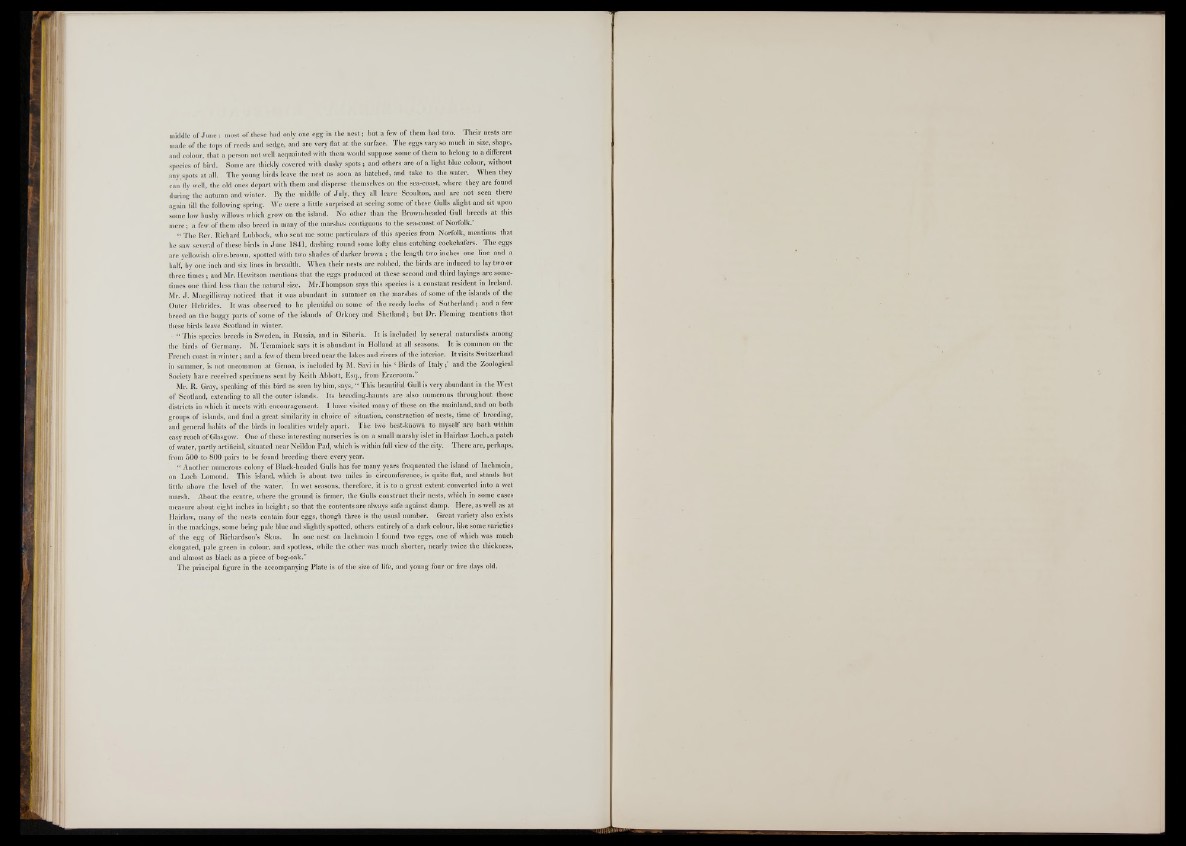
middle of June: most of these had only one egg in the nest ; hot a few o f them had two. Their nests are
made of the tops of reeds and sedge, and are very flat at the surface. The eggs vary so much in size, shape,
and colour, that a person not well acquainted with them would suppose some o f them to belong to a different
species of bird. Some are thickly covered with dusky spots s and others are o f a light blue colour, without
any spots at all. The young birds leave the nest as soon as hatched, and take to the water. When they
can fly well, the old ones depart with them and disperse themselves on the sea-coast, where they are found
during the autumn and winter. By the middle o f July, they all leave Scoulton, and are not seen there
again till the following spring. We were a little surprised at seeing some o f these Gulls alight and sit upon
some low bushy willows which grow on the island. No other than the Brown-headed Gull breeds at this
mere; a few of them also breed in many o f the marshes contiguous to the sea-coast o f Norfolk.’
“ The Rev. Richard Lubbock, who sent me some particulars of this species from Norfolk, mentions that
be saw several of these birds in June 1841, dashing round some lofty elms catching cockchafers. The eggs
are yellowish olive-brown, spotted with two shades o f darker brown ; the length two inches one line and a
half, by one inch and six lines in breadth. When their nests are robbed, the birds are induced to lay two or
three times ■, and Mr. Hewitson mentions that the eggs produced at these second and third layings are sometimes
one third less than the natural size. Mr .Thompson says this species-is a constant resident in Ireland.
Mr. J . Macgillivray noticed that it was abundant in summer on the marshes o f some o f the islands o f the
Outer Hebrides. It was observed to be plentiful on some o f the reedy lochs o f Sutherland; and a few
breed on the boggy parts of some of the islands o f Orkney and Shetland; but Dr. Fleming mentions that
these birds leave Scotland in winter.
• “ This species breeds in Sweden, in Russia, and in Siberia. It is included by several naturalists among
the birds of Germany. M. Temminck says it is abundant in Holland at all seasons. It is common on the
French coast in winter; and a few of them breed near the lakes and rivers o f the interior. It visits Switzerland
in summer, is not uncommon at Genoa, is included by M. Savi in his ‘ Birds o f I t a l y a n d the Zoological
Society have received specimens sent by Keith Abbott, Esq., from Erzeroom.”
Mr. R. Gray, speaking o f this bird as seen by him, says, “ This beautiful Gull is very abundant in the West
of Scotland, extending to all the outer islands. Its breeding-haunts are also numerous throughout those
districts in which it meets with encouragement. I have visited many o f these on the mainland, and on both
groups o f islands, and find a great similarity in choice of situation, construction o f nests, time o f breeding,
and general habits of the birds in localities widely apart. The two best-known to myself are both within
easy reacb o f Glasgow. One of these interesting nurseries is on a small marshy islet in Hairlaw Loch, a patch
of water, partly artificial, situated near Neildon Pad, which is within full view o f the city. There are, perhaps,
from 500 to 800 pairs to be found breeding there every year.
“ Another numerous colony o f Black-headed Gulls has for many years frequented the island of Inchmoin,
on Loch Lomond. This island, which is about two miles in circumference, is quite flat, and stands but
little above the level of the water. In wet seasons, therefore, it is to a great extent converted into a wet
marsh. About the centre, where the ground is firmer, the Gulls construct their nests, which in some cases
measure about eight inches in height; so that the contents are always safe against damp. Here, as well as at
Hairlaw, many o f the nests contain four eggs, though three is the usual number. Great variety also exists
in the markings, some being pale blue and slightly spotted, others entirely o f a dark colour, like some varieties
of the egg of Richardson’s Skua. In one nest on Inchmoin I found two eggs, one of which was much
elongated, pale green in colour, and spotless, while the other was much shorter, nearly twice the thickness,
and almost as hlack as a piece o f bog-oak.”
The principal figure in the accompanying Plate is o f the size o f life, and young four or five days old.